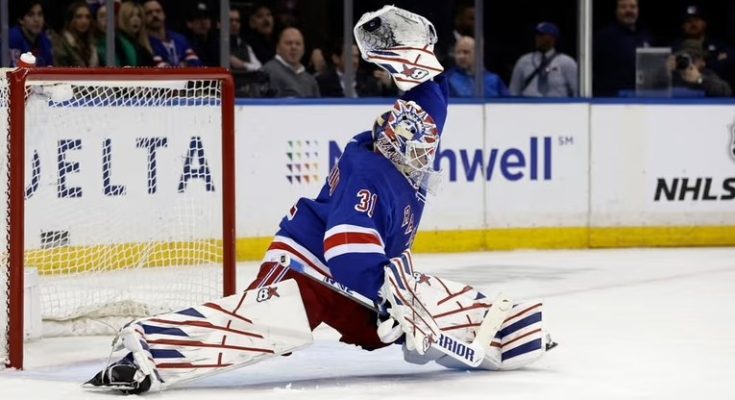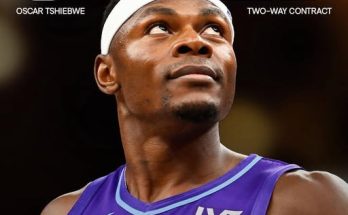Igor Shesterkin’s latest contract extension with the New York Rangers has taken an unexpected turn ahead of the 2025-26 NHL season, and the ripple effects of this development are being felt not just in New York but across the entire hockey landscape. In a sport where stability between the pipes often defines whether a team can contend for a Stanley Cup, the fate of the Rangers’ franchise goaltender was always going to carry outsized importance. Yet the way this extension unfolded, and the questions it now raises, have made it one of the most intriguing storylines of the offseason.
Shesterkin, who has been the backbone of the Rangers since his arrival from Russia in 2020, has long been seen as the heir to Henrik Lundqvist’s throne, the steady presence in net capable of stealing games, carrying a team through playoff series, and serving as the anchor of a defense-first identity. His 2021-22 Vezina Trophy season cemented him as one of the league’s truly elite goaltenders, and his consistency since then has ensured that he is always in the conversation when discussing the top three goalies in the world. But contract negotiations with goalies at this level are never straightforward. In the salary-cap era, committing big money and long years to a netminder requires organizational confidence not just in the player’s talent but in his ability to withstand the physical grind and mental demands of such a specialized position well into his 30s.
For months, speculation swirled about how the Rangers would handle Shesterkin’s next deal. Some insiders believed he would receive the richest goalie contract in NHL history, potentially eclipsing Sergei Bobrovsky’s massive deal in Florida. Others thought the Rangers might push for a shorter-term extension, preserving flexibility while still rewarding their star. What few expected, however, was the twist that emerged: a contract structure that, while lucrative, came with unusual performance-based elements and outs for both the team and the player that suggest caution on both sides.
The Rangers reportedly structured the deal to include a base salary that places Shesterkin among the league’s highest-paid goalies, but the eye-opening detail lies in the bonuses and escalators. His annual earnings will fluctuate depending on games played, playoff appearances, and even team success metrics like save percentage relative to league average. While incentive-laden contracts are common in many sports, especially for players coming off injuries, they are far less common for players of Shesterkin’s caliber in the NHL, where guaranteed contracts have been the norm for established stars. For the Rangers to negotiate such terms suggests they are hedging against concerns about workload, injury risk, or perhaps even the volatility that has always come with the goaltending position.
For Shesterkin, agreeing to these terms was itself an unexpected decision. Star players often push hard for guaranteed security, and few would have faulted him if he had refused such a structure. Instead, his willingness to accept the deal signals confidence in his ability to continue producing at an elite level and perhaps even to capitalize on those performance incentives. In some ways, this shows his competitive edge: he is betting on himself, wagering that he will hit those marks and, in doing so, drive his earnings beyond even the most generous guaranteed contracts. At the same time, it raises questions about how satisfied he is with the Rangers’ current trajectory and whether the flexibility built into the deal might leave the door open for a departure down the road.
The timing of the extension adds another layer of intrigue. Entering the 2025-26 season, the Rangers are at a crossroads. Their core of Artemi Panarin, Mika Zibanejad, Adam Fox, and Alexis Lafrenière remains intact, but the team has not yet broken through in the postseason in the way many expected when Shesterkin emerged as a star. Deep playoff runs have been elusive, and each missed opportunity has added to the pressure. By extending Shesterkin, the Rangers have at least guaranteed that their most important player is under contract, but the unconventional nature of the deal raises questions about long-term stability. Is this the sign of a front office trying to balance championship aspirations with financial caution, or does it reflect deeper uncertainty about how long this competitive window will remain open?
One of the most fascinating dimensions of this story is the way it reflects broader league trends. In recent years, general managers have grown more reluctant to hand out massive long-term deals to goaltenders, no matter how talented. The position is notoriously unpredictable, with performance swings from year to year that can defy logic. Even established stars like Carey Price and Sergei Bobrovsky have seen stretches of inconsistency that made their hefty contracts look burdensome. The Rangers, then, may simply be learning from history, crafting a deal that protects them if Shesterkin’s performance dips or if injuries take a toll. Yet there is a flip side: by taking this cautious approach, they risk alienating a player who has been nothing short of exceptional.
For Shesterkin himself, this contract extension will now define the narrative of his next several seasons. Every save, every loss, every playoff series will be viewed through the lens of his deal. If he meets the performance thresholds and the Rangers thrive, he will be heralded as not only a generational goaltender but also a shrewd negotiator who maximized his earnings while proving his value. If he struggles, the contract will be scrutinized as a sign that both he and the organization foresaw potential cracks in the armor. In the high-pressure world of New York sports, where media attention is relentless and fan expectations sky-high, this kind of scrutiny can weigh heavily. But Shesterkin has shown time and again that he thrives under pressure, turning criticism into motivation.
Another layer worth examining is the impact this deal could have on the Rangers’ roster construction moving forward. With significant money tied up in their core forwards and defensemen, managing the salary cap has always been a delicate balance for the front office. A traditional long-term, guaranteed contract for Shesterkin might have locked the team into a rigid structure, limiting flexibility in filling out the roster. By introducing performance-based elements, the Rangers may have bought themselves just enough wiggle room to adjust depending on how the next few seasons unfold. For example, if Shesterkin earns every possible bonus, the team will likely be contending deep into the playoffs, justifying the cost. If not, they will have slightly more financial room to retool.
The reaction around the league has been one of surprise, mixed with curiosity. Rival teams see the deal as a bold experiment that could set a precedent for future goaltending contracts. If successful, it might encourage other front offices to explore similar structures, particularly for players in volatile positions. If it backfires, it will serve as a cautionary tale of overthinking negotiations with a franchise cornerstone. For players and agents, the deal represents both a challenge and an opportunity: how far are stars willing to go to bet on themselves, and how much leverage do teams really have in these negotiations?
Fans, of course, view the extension through an emotional lens. For Rangers supporters, the most important outcome was always ensuring Shesterkin remained in blue. The idea of him testing free agency or, worse, landing with a rival would have been unthinkable. While the details of the contract may raise eyebrows, the fact that their star goaltender is committed to the team is cause for relief. Still, the unexpected nature of the terms has sparked debates on sports talk radio, in online forums, and in conversations across New York. Some praise Shesterkin’s confidence and the front office’s creativity, while others worry the unusual structure could lead to tension if things do not go according to plan.
Looking ahead to the 2025-26 season, the spotlight on Shesterkin will be brighter than ever. The Rangers’ hopes of competing for a Stanley Cup still rest squarely on his shoulders. Their defense remains solid but not impenetrable, meaning they will need him to provide the game-stealing performances that have become his trademark. Their offense is potent but streaky, and in tight playoff series, a hot goaltender often makes the difference. In this context, Shesterkin’s contract is more than just a financial agreement—it is a symbol of the team’s belief in him and a test of his ability to deliver on that faith.
What makes this development truly compelling is that it blurs the line between certainty and uncertainty. By extending Shesterkin, the Rangers have secured their most vital player, but by structuring the contract in such an unconventional way, they have introduced new variables into the equation. For fans and analysts, this means the story is far from over. Every milestone Shesterkin hits, every bonus he unlocks, every playoff appearance will add another chapter to this saga. In some ways, the deal has transformed his journey into a high-stakes drama that will play out in real time, with implications for his legacy, the Rangers’ future, and perhaps even the broader landscape of NHL contracts.
Ultimately, Igor Shesterkin’s latest contract extension is not just a financial agreement but a statement about risk, reward, and the evolving nature of team-building in the NHL. It reflects the unique pressures of playing in New York, the delicate balance of managing a salary cap, and the unpredictable reality of goaltending. It shows a star player willing to bet on himself and a franchise willing to innovate, even at the risk of controversy. And most importantly, it ensures that as the Rangers chase glory in the 2025-26 season and beyond, the man wearing number 31 will be right at the center of it all—carrying not only the weight of the puck but the hopes of a city and the expectations of a league watching closely.



